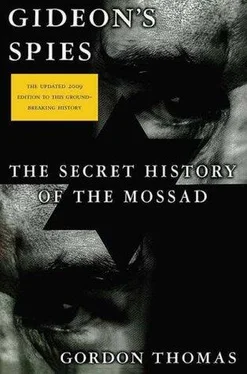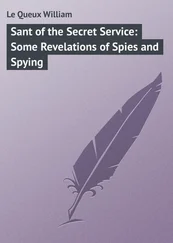Gordon Thomas - Gideon's Spies
Здесь есть возможность читать онлайн «Gordon Thomas - Gideon's Spies» весь текст электронной книги совершенно бесплатно (целиком полную версию без сокращений). В некоторых случаях можно слушать аудио, скачать через торрент в формате fb2 и присутствует краткое содержание. Город: New York, Год выпуска: 2009, ISBN: 2009, Издательство: Thomas Dunne Books, Жанр: История, на английском языке. Описание произведения, (предисловие) а так же отзывы посетителей доступны на портале библиотеки ЛибКат.
- Название:Gideon's Spies
- Автор:
- Издательство:Thomas Dunne Books
- Жанр:
- Год:2009
- Город:New York
- ISBN:978-0-312-53901-6
- Рейтинг книги:4 / 5. Голосов: 1
-
Избранное:Добавить в избранное
- Отзывы:
-
Ваша оценка:
- 80
- 1
- 2
- 3
- 4
- 5
Gideon's Spies: краткое содержание, описание и аннотация
Предлагаем к чтению аннотацию, описание, краткое содержание или предисловие (зависит от того, что написал сам автор книги «Gideon's Spies»). Если вы не нашли необходимую информацию о книге — напишите в комментариях, мы постараемся отыскать её.
Gideon’s Spies
Gideon's Spies — читать онлайн бесплатно полную книгу (весь текст) целиком
Ниже представлен текст книги, разбитый по страницам. Система сохранения места последней прочитанной страницы, позволяет с удобством читать онлайн бесплатно книгу «Gideon's Spies», без необходимости каждый раз заново искать на чём Вы остановились. Поставьте закладку, и сможете в любой момент перейти на страницу, на которой закончили чтение.
Интервал:
Закладка:
Ostrovsky would claim that the carefully prepared Mossad plan to kill Maxwell hinged on being able to persuade him to keep a rendezvous where Mossad could strike. It had a striking similarity to the plot that had led to the death of Mehdi Ben-Barka in Paris.
On October 29, 1991, Maxwell received a call from a katsa at the Israeli embassy in Madrid. Maxwell was asked to come to Spain the next day, and, according to Ostrovsky, “his caller promised that things would be worked out so there was no need to panic.” Maxwell was told to fly to Gibraltar and board his yacht, the Lady Ghislaine, and order the crew to set sail for the Canary Islands “and wait there for a message.”
Robert Maxwell agreed to do as instructed.
On October 30, four Israelis arrived in the Moroccan port of Rabat. They said they were tourists on a deep-sea fishing vacation and hired an oceangoing motor yacht. They set off toward the Canary Islands.
On October 31, after Maxwell reached the port of Santa Cruz on the island of Tenerife, he dined alone in the Hotel Mency. After dinner a man briefly joined him. Who he was and what they spoke about remain part of the mystery of the last days of Robert Maxwell. Shortly afterward, Maxwell returned to his yacht and ordered it back to sea. For the next thirty-six hours, the Lady Ghislaine sailed between the islands, keeping well clear of land, cruising at various speeds. Maxwell had told the captain he was deciding where to go next. The crew could not recall Maxwell showing such indecision.
In what it claimed was a “world exclusive,” headlined “How and why Robert Maxwell was murdered,” Britain’s Business Age magazine subsequently claimed that a two-man hit team crossed in a dinghy during the night from a motor yacht that had shadowed the Lady Ghislaine. Boarding the yacht, they found Maxwell on the afterdeck. The men overpowered him before he could call for help. Then, “one assassin injected a bubble of air into Maxwell’s neck via his jugular vein. It took just a few moments for Maxwell to die.”
The magazine concluded the body was dropped overboard and the assassins returned to their yacht. It would be sixteen hours before Maxwell was recovered—enough time for a needle prick to recede beyond detection as a result of water immersion and the skin being nibbled by fish.
More certain, on the night of November 4–5, Mossad’s problems with Maxwell were laid to rest in the cold swell of the Atlantic. The subsequent police investigation and the Spanish autopsy left unanswered questions. Why were only two of the yacht’s eleven-man crew awake? Normally five shared the night watch. To whom did Maxwell send a number of fax messages during those hours? What became of the copies? Why did the crew take so long to establish Maxwell was not on board? Why did they delay raising the alarm for a further seventy minutes? To this day no convincing answers have emerged.
Three Spanish pathologists were assigned to perform the autopsy. They wanted the vital organs and tissue to be sent to Madrid for further tests. Before this could be done, the Maxwell family intervened, ordering the body embalmed and flown forthwith to Israel for burial. The Spanish authorities, unusually, did not object.
Who or what had persuaded the family to suddenly act as it did?
On November 10, 1991, Maxwell’s funeral took place on the Mount of Olives in Jerusalem, the resting place for the nation’s most revered heroes. It had all the trappings of a state occasion, attended by the country’s government and opposition leaders. No fewer than six serving and former heads of the Israeli intelligence community listened as Prime Minister Shamir eulogized: “He has done more for Israel than can today be said.”
Those who stood among the mourners included a man dressed in a somber black suit and shirt, relieved only at the throat by his Roman collar. Born into a Lebanese Christian family, he was a wraithlike figure—barely five feet tall and weighing little over a hundred pounds. But Father Ibrahim was no ordinary priest. He worked for the Vatican’s Secretariat of State.
His discreet presence at the funeral was not so much to mark the earthly passing of Robert Maxwell, but to acknowledge the still-secret ties developing between the Holy See and Israel. It was a perfect example of Meir Amit’s dictum that intelligence cooperation knows no limits.
CHAPTER 11
UNHOLY ALLIANCES
From the beginning, successive Israeli prime ministers had been fascinated by the concept of the pope as an absolute ruler elected for life, a leader not held accountable to any judiciary or legislative control. Using a pyramidic and monarchical structure, the supreme pontiff wielded extraordinary influence to shape the economic, political, and ideological outlook of not only the Catholic faithful but the world at large. David Ben-Gurion once growled: “Never mind that nonsense about how many divisions does the pope have—just look at how many people he can summon to his aid.”
For Mossad, the appeal was the sheer secrecy with which the Vatican operated. It was a well-defined mechanism, strictly enforced, and it cloaked everything the Holy See did. Often months passed before the first hints emerged of papal involvement in some diplomatic initiative; even then the full story rarely surfaced. Each Mossad chief wondered how to penetrate the veil. But various attempts by both the government of Israel and Mossad to establish a good working relationship with the Vatican had been politely but firmly rejected.
The reality was that within the Holy See’s Secretariat of State—the equivalent of a secular foreign office—there existed a powerful anti-Israeli faction. These soutaned monsignors would invariably refer to the West Bank and the Gaza Strip as “occupied territories” and the Golan Heights as having been “annexed” from Syria. In the evenings, they would drive out of their tiny city-state to the apartments of wealthy Arabs on Rome’s Via Condotti, or join them for cocktails in the Piazza Navona, dispassionately listening to dreams of removing Israel from the face of the earth.
The priests were careful what they said; they believed the Jewish state had its agents everywhere, watching, listening, perhaps even recording and photographing. One of the first warnings a newcomer to the Secretariat received was to be aware of being “spied or enveigled upon, especially by agents from countries the Vatican firmly refuses to diplomatically recognize.” Israel was high on that list. Upon his election in 1978, Pope John Paul II had reaffirmed it would remain there; only well into his pontificate would he finally agree to grant full diplomatic status to Israel.
The information the pope received about Israel continued to be influenced by contacts his priest-diplomats made with Arabs. Their forays into Rome were followed by the monsignors returning to the third floor of the Apostolic Palace, the overcrowded, artificially lit, and poorly ventilated headquarters of the papal diplomatic service. Known as the Extraordinary Affairs Section, it was responsible for implementing the foreign policy of the Holy See. Its twenty “desks” dealt with almost as much paperwork as other major foreign ministries, a measure of the Vatican’s ever expanding worldwide diplomatic interests.
The Middle East desk was housed in cubbyhole offices overlooking the San Damaso Courtyard, a magnificent piazza in the heart of the great palace. One of the first papers the desk presented to the new Polish pontiff was a closely argued case for Jerusalem to have international status and be patrolled by United Nations forces with the Vatican having responsibility for all the city’s Christian shrines. News of the proposal reached Tel Aviv early in 1979, having been photocopied from a document passed by a monsignor to a wealthy Lebanese Christian living in Rome. The man’s staff included a Mossad sayan. The prospect of internationalizing Jerusalem angered Prime Minister Menachem Begin, who ordered Mossad’s chief, Yitzhak Hofi, to redouble his efforts to establish contact with the Vatican.
Читать дальшеИнтервал:
Закладка:
Похожие книги на «Gideon's Spies»
Представляем Вашему вниманию похожие книги на «Gideon's Spies» списком для выбора. Мы отобрали схожую по названию и смыслу литературу в надежде предоставить читателям больше вариантов отыскать новые, интересные, ещё непрочитанные произведения.
Обсуждение, отзывы о книге «Gideon's Spies» и просто собственные мнения читателей. Оставьте ваши комментарии, напишите, что Вы думаете о произведении, его смысле или главных героях. Укажите что конкретно понравилось, а что нет, и почему Вы так считаете.












